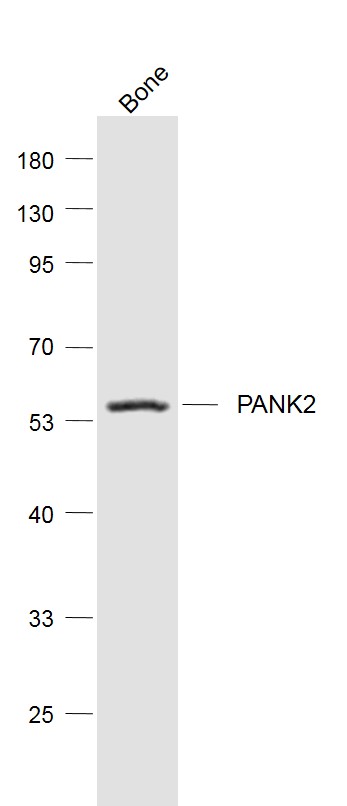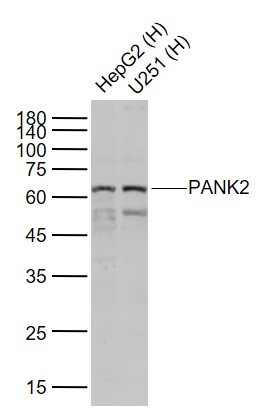
Rabbit Anti-PANK2 antibody
C20orf48; HARP; hPANK2; HSS; MGC15053; NBIA1; PANK2; PANK2_HUMAN; Pantothenate kinase 2 (Hallervorden Spatz syndrome); Pantothenate kinase 2; Pantothenic acid kinase 2; PKAN; RP23 387C21.4.
View History [Clear]
Details
Product Name PANK2 Chinese Name 泛酸激酶2抗体 Alias C20orf48; HARP; hPANK2; HSS; MGC15053; NBIA1; PANK2; PANK2_HUMAN; Pantothenate kinase 2 (Hallervorden Spatz syndrome); Pantothenate kinase 2; Pantothenic acid kinase 2; PKAN; RP23 387C21.4. literatures Research Area Tumour Cell biology immunology Neurobiology Signal transduction Immunogen Species Rabbit Clonality Polyclonal React Species Human, Mouse, (predicted: Rat, Dog, Pig, Cow, Horse, ) Applications WB=1:500-2000 ELISA=1:5000-10000 IHC-P=1:100-500 IHC-F=1:100-500 IF=1:50-200 (Paraffin sections need antigen repair)
not yet tested in other applications.
optimal dilutions/concentrations should be determined by the end user.Theoretical molecular weight 57kDa Cellular localization cytoplasmic Form Liquid Concentration 1mg/ml immunogen KLH conjugated synthetic peptide derived from human PANK2: 401-500/570 Lsotype IgG Purification affinity purified by Protein A Buffer Solution 0.01M TBS(pH7.4) with 1% BSA, 0.03% Proclin300 and 50% Glycerol. Storage Shipped at 4℃. Store at -20 °C for one year. Avoid repeated freeze/thaw cycles. Attention This product as supplied is intended for research use only, not for use in human, therapeutic or diagnostic applications. PubMed PubMed Product Detail Defects in PANK2 are the cause of neurodegeneration with brain iron accumulation type 1 (NBIA1); also known as pantothenate kinase-associated neurodegeneration (PKAN) or Hallervorden-Spatz syndrome (HSS). It is an autosomal recessive neurodegenerative disorder associated with iron accumulation in the brain, primarily in the basal ganglia. Clinical manifestations include progressive muscle spasticity, hyperreflexia, muscle rigidity, dystonia, dysarthria, and intellectual deterioration which progresses to severe dementia over several years. It is clinically classified into classic, atypical, and intermediate phenotypes. Classic forms present with onset in the first decade, rapid progression, loss of independent ambulation within 15 years. Atypical forms have onset in the second decade, slow progression, maintenance of independent ambulation up to 40 years later. Intermediate forms manifest onset in the first decade with slow progression or onset in the second decade with rapid progression. Patients with early onset tend to also develop pigmentary retinopathy, whereas those with later onset tend to also have speech disorders and psychiatric features. All patients have the 'eye of the tiger' sign on brain MRI.
Defects in PANK2 are the cause of hypoprebetalipoproteinemia, acanthocytosis, retinitis pigmentosa, and pallidal degeneration (HARP). HARP is a rare syndrome with many clinical similarities to NBIA1.
Function:
May be the master regulator of the CoA biosynthesis (By similarity).
Subcellular Location:
Isoform 1: Mitochondrion.
Isoform 2: Cytoplasm (Potential).
Tissue Specificity:
Ubiquitous.
DISEASE:
Defects in PANK2 are the cause of neurodegeneration with brain iron accumulation type 1 (NBIA1) [MIM:234200]; also known as pantothenate kinase-associated neurodegeneration (PKAN) or Hallervorden-Spatz syndrome (HSS). It is an autosomal recessive neurodegenerative disorder associated with iron accumulation in the brain, primarily in the basal ganglia. Clinical manifestations include progressive muscle spasticity, hyperreflexia, muscle rigidity, dystonia, dysarthria, and intellectual deterioration which progresses to severe dementia over several years. It is clinically classified into classic, atypical, and intermediate phenotypes. Classic forms present with onset in the first decade, rapid progression, loss of independent ambulation within 15 years. Atypical forms have onset in the second decade, slow progression, maintenance of independent ambulation up to 40 years later. Intermediate forms manifest onset in the first decade with slow progression or onset in the second decade with rapid progression. Patients with early onset tend to also develop pigmentary retinopathy, whereas those with later onset tend to also have speech disorders and psychiatric features. All patients have the 'eye of the tiger' sign on brain MRI.
Defects in PANK2 are the cause of hypoprebetalipoproteinemia, acanthocytosis, retinitis pigmentosa, and pallidal degeneration (HARP) [MIM:607236]. HARP is a rare syndrome with many clinical similarities to NBIA1.
Similarity:
Belongs to the type II pantothenate kinase family.
SWISS:
Q9BZ23
Gene ID:
80025
Database links:Entrez Gene: 80025 Human
Omim: 606157 Human
SwissProt: Q9BZ23 Human
Unigene: 516859 Human
Product Picture
Bone (Mouse) Lysate at 40 ug
Primary: Anti-PANK2 (SL8338R) at 1/1000 dilution
Secondary: IRDye800CW Goat Anti-Rabbit IgG at 1/20000 dilution
Predicted band size: 57 kD
Observed band size: 57 kD
References (0)
No References
Bought notes(bought amounts latest0)
No one bought this product
User Comment(Total0User Comment Num)
- No comment




 +86 571 56623320
+86 571 56623320
 +86 18668110335
+86 18668110335

